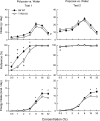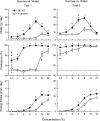T1R3 taste receptor is critical for sucrose but not Polycose taste
- PMID: 19091911
- PMCID: PMC2698610
- DOI: 10.1152/ajpregu.90870.2008
T1R3 taste receptor is critical for sucrose but not Polycose taste
Abstract
In addition to their well-known preference for sugars, mice and rats avidly consume starch-derived glucose polymers (e.g., Polycose). T1R3 is a component of the mammalian sweet taste receptor that mediates the preference for sugars and artificial sweeteners in mammals. We examined the role of the T1R3 receptor in the ingestive response of mice to Polycose and sucrose. In 60-s two-bottle tests, knockout (KO) mice preferred Polycose solutions (4-32%) to water, although their overall preference was lower than WT mice (82% vs. 94%). KO mice also preferred Polycose (0.5-32%) in 24-h two-bottle tests, although less so than WT mice at dilute concentrations (0.5-4%). In contrast, KO mice failed to prefer sucrose to water in 60-s tests. In 24-h tests, KO mice were indifferent to 0.5-8% sucrose, but preferred 16-32% sucrose; this latter result may reflect the post-oral effects of sucrose. Overall sucrose preference and intake were substantially less in KO mice than WT mice. However, when retested with 0.5-32% sucrose solutions, the KO mice preferred all sucrose concentrations, although they drank less sugar than WT mice. The experience-induced sucrose preference is attributed to a post-oral conditioned preference for the T1R3-independent orosensory features of the sugar solutions (odor, texture, T1R2-mediated taste). Chorda tympani nerve recordings revealed virtually no response to sucrose in KO mice, but a near-normal response to Polycose. These results indicate that the T1R3 receptor plays a critical role in the taste-mediated response to sucrose but not Polycose.
Figures





Similar articles
-
T1R2 and T1R3 subunits are individually unnecessary for normal affective licking responses to Polycose: implications for saccharide taste receptors in mice.Am J Physiol Regul Integr Comp Physiol. 2009 Apr;296(4):R855-65. doi: 10.1152/ajpregu.90869.2008. Epub 2009 Jan 21. Am J Physiol Regul Integr Comp Physiol. 2009. PMID: 19158407 Free PMC article.
-
The role of T1r3 and Trpm5 in carbohydrate-induced obesity in mice.Physiol Behav. 2012 Aug 20;107(1):50-8. doi: 10.1016/j.physbeh.2012.05.023. Epub 2012 Jun 6. Physiol Behav. 2012. PMID: 22683548 Free PMC article.
-
Sugar-induced cephalic-phase insulin release is mediated by a T1r2+T1r3-independent taste transduction pathway in mice.Am J Physiol Regul Integr Comp Physiol. 2015 Sep;309(5):R552-60. doi: 10.1152/ajpregu.00056.2015. Epub 2015 Jul 8. Am J Physiol Regul Integr Comp Physiol. 2015. PMID: 26157055 Free PMC article.
-
The functional role of the T1R family of receptors in sweet taste and feeding.Physiol Behav. 2011 Nov 30;105(1):14-26. doi: 10.1016/j.physbeh.2011.02.030. Epub 2011 Mar 2. Physiol Behav. 2011. PMID: 21376068 Free PMC article. Review.
-
Starch and sugar tastes in rodents: an update.Brain Res Bull. 1991 Sep-Oct;27(3-4):383-6. doi: 10.1016/0361-9230(91)90129-8. Brain Res Bull. 1991. PMID: 1959034 Review.
Cited by
-
Taste perception of cyclic oligosaccharides: α, β, and γ cyclodextrins.Chem Senses. 2022 Jan 1;47:bjac006. doi: 10.1093/chemse/bjac006. Chem Senses. 2022. PMID: 35397161 Free PMC article.
-
Rapid post-oral stimulation of intake and flavor conditioning by glucose and fat in the mouse.Am J Physiol Regul Integr Comp Physiol. 2011 Dec;301(6):R1635-47. doi: 10.1152/ajpregu.00425.2011. Epub 2011 Oct 5. Am J Physiol Regul Integr Comp Physiol. 2011. PMID: 21975648 Free PMC article.
-
Behavioral evidence that select carbohydrate stimuli activate T1R-independent receptor mechanisms.Appetite. 2018 Mar 1;122:26-31. doi: 10.1016/j.appet.2016.12.031. Epub 2016 Dec 26. Appetite. 2018. PMID: 28034739 Free PMC article.
-
Linking peripheral taste processes to behavior.Curr Opin Neurobiol. 2009 Aug;19(4):370-7. doi: 10.1016/j.conb.2009.07.014. Epub 2009 Aug 10. Curr Opin Neurobiol. 2009. PMID: 19674892 Free PMC article. Review.
-
Rats' preferences for high fructose corn syrup vs. sucrose and sugar mixtures.Physiol Behav. 2011 Mar 28;102(5):548-52. doi: 10.1016/j.physbeh.2011.01.004. Epub 2011 Jan 12. Physiol Behav. 2011. PMID: 21236278 Free PMC article.
References
Publication types
MeSH terms
Substances
Grants and funding
LinkOut - more resources
Full Text Sources
Research Materials

